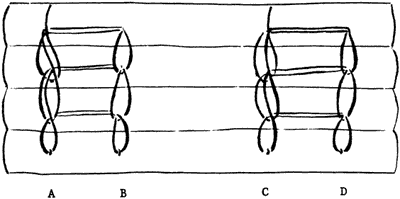A Trial Terminology for Sewing Through the Fold
by Pamela Spitzmueller and Gary FrostThis guide is an aid to recording a sewing thread's path through the folds of a book. While historical bindings have come down to us; a specific, accompanying terminology of construction, if it ever existed, has not been recorded. We have attempted to fill this gap by supplying a "trial" vocabulary for descriptive recording. The sewing process/product is broken into three categories—the motions of a thread to form a stitch; the patterns formed by a sequence of stitches, either in the fold or across the spine; the broad structure of text-block construction.
A stitch, the first viewpoint, is defined as the motion of a thread from a sewing station exit to a sewing station entry. Thirteen words make up the stitch vocabulary.
I. Sewing Stitch
Patterns, the second viewpoint, are sequences of stitches. The thread at the innermost folio of a section can be located and observed throughout the book. The sequence noted can be described by the fold pattern terminology. Fold patterns are divided into two types—periodic and continuous. Periodic have intervals between some of the stations and continuous do not.
II. Sewing Pattern
Fold pattern
Periodic—intervals between some stations
| in-line | 
|
| staggered | 
|
| erratic | 
|
Continuous—without intervals between stations simple
| simple | |
| multiple | |
| head to tail | |
| skip station |
The other type of sewing pattern is the backbone pattern. These patterns are the sequences of stitches seen on the backbone of the book.
Backbone pattern
| chain | |
| rib | |
| chevron | |
| step |
The third viewpoint is structure. Supported sewing utilizes a shared part to which the sections are secured via the thread. Unsupported sewing uses only the thread to secure the sections to each other.
III. Sewing Structure
Supported sewing
Unsupported sewing
SAMPLE
Unsupported structure.
Chain pattern across spine; in-line, periodic
fold pattern. There are four sewing stations—A is at the head and D is at
the tail. Two needles are used, each sewing between two stations—A & B
or C & D. They sew independently but identically. Enter at A, continue-on to
B, exit, drop to-the-outside, link, climb, enter at B, reverse, exit at A, drop
to-the-outside, link, climb, changeover and enter at A in the next
section.
Publication History
Received: Fall 1982
Paper delivered at the Book and Paper specialty group session, AIC 10th Annual Meeting, May 26-30. 1982, Mailwaukee, Wisconsin.
Papers for the specialty group session are selected by committee, based on abstracts and there has been no further peer review. Papers are received by the compiler in the Fall following the meeting and the author is welcome to make revisions, minor or major.
